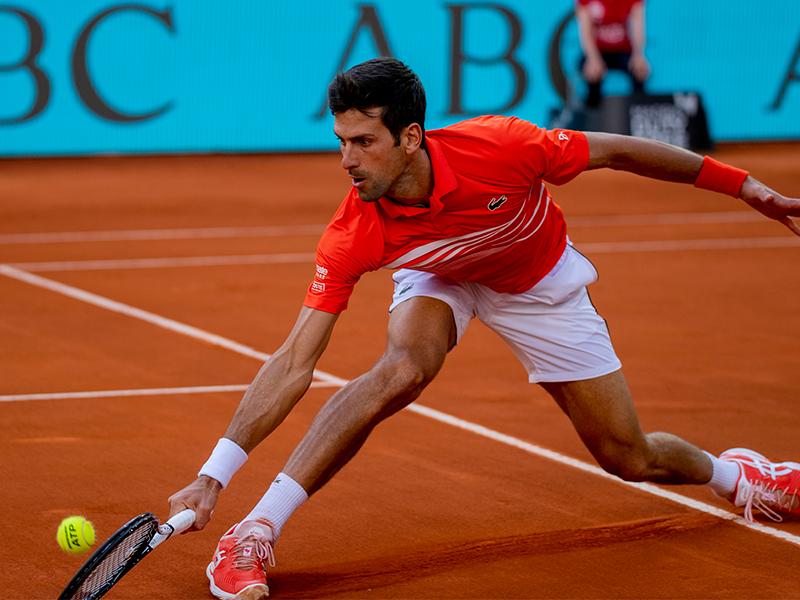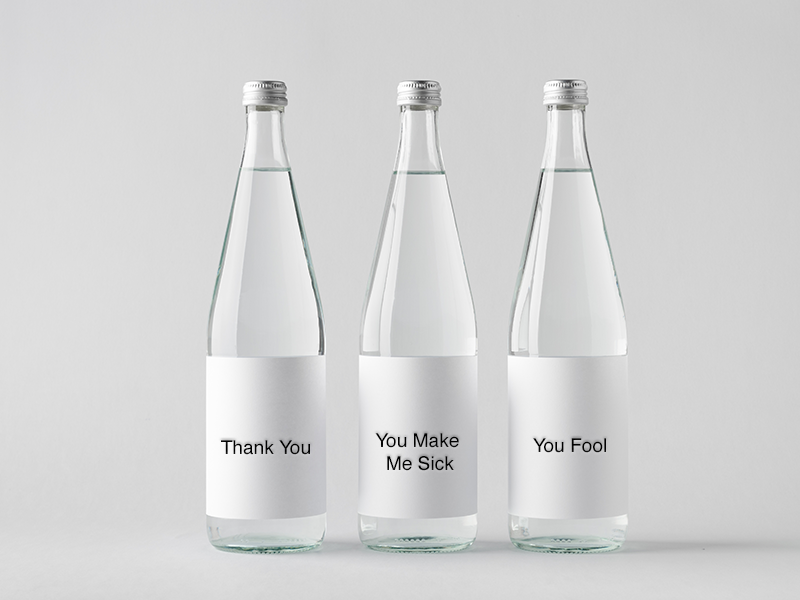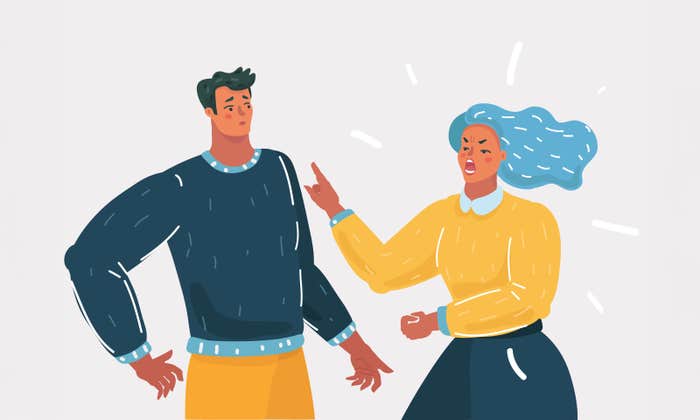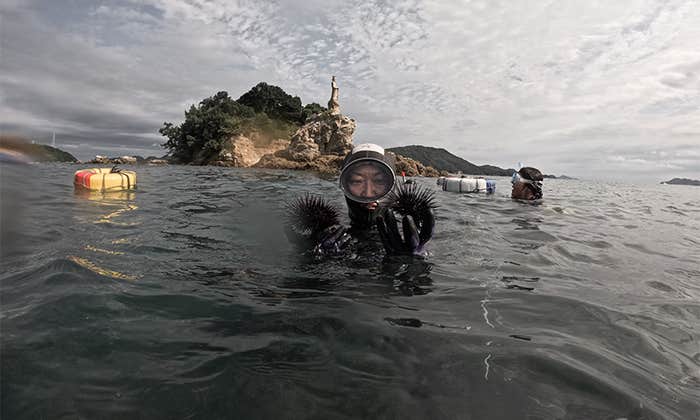At the end of every tennis match that he wins, Novak Djokovic sweeps his hands to his heart and opens his arms to the crowd, sending them his love. At trophy ceremonies, he thanks the people involved in the tournament, from the executives standing at his side whose companies have funded the tournaments, to the ball kids who toss him balls to serve—usually with a little tremble, as Djokovic is often sizzling with impatience. The gratitude is expected of him, but he’s gracious in his delivery. He’s aware that all the parts must click together to create the tournaments that have made him, a boy from Serbia, a wealthy man.
Throughout his career, Djokovic has spoken warmly about the fact that he hasn’t achieved his success alone, that his family, coaches, and country have helped make him the champion he is. His nonprofit foundation builds and renovates preschools and kindergartens in Serbia. It’s bought ventilators for Serbian hospitals during the pandemic. It recently funded a sculpture created by Serbian kids about Nikolai Tesla, “Wings Are Everything in Life,” about the great scientist’s love and admiration of birds. Djokovic is also behind a new tennis union that would help low-ranked players earn wider shares of pro tennis industry profits. He’s affable and funny, a spot-on mimic of other players’ mannerisms and styles.
Then there’s his own playing style. If the definition of intelligence is the ability to absorb problems, solve them, and strike a new way forward, Djokovic is a genius. On a tennis court he has the perspective of Pythagoras and the reflexes of a gazelle. He tracks down and returns shots at angles that mere mortal players don’t see.
I have dipped my toes in New Age waters in the past. But this deep dive took my breath away.
This past January, Djokovic made headlines outside tennis for his decision to remain unvaccinated for COVID-19. Being vaccinated protects one’s health and tamps down SARS-Cov-2’s tendency to mutate, spread, and infect others. Getting vaccinated is an act of responsibility that stems from the values Djokovic expresses, that we are members of a community whose lives and achievements can’t be separated.
Australia, “in the public interest,” canceled Djokovic’s visa and he didn’t play in the Australian Open, a “Grand Slam” tournament, one of the sport’s most prestigious. Had Djokovic won the tournament, he would have stood alone as the male player with the most Grand Slam victories in history. As it turned out, one of his main rivals, Rafael Nadal, won the tournament, and now holds the record. Most media commentary on the affair concluded Djokovic could have avoided his legal defeat had he simply got vaccinated like his fellow players, and 4.7 billion people around the world.1
That’s true, but why? Why did a fierce athlete with a record-breaking goal in his sights not do the simple thing? Why did a man so intelligent and sympathetic to others not do the right thing?

The closest Djokovic has come to a public explanation was in a New York Times interview in August 2020. “My issue here with vaccines is if someone is forcing me to put something in my body,” he said. “That I don’t want. For me that’s unacceptable. I am not against vaccination of any kind, because who am I to speak about vaccines when there are people that have been in the field of medicine and saving lives around the world?”
Djokovic’s response is honest and respectful. But it underscores the question of why a conscientious person wouldn’t put something in his body that has saved lives around the world, especially when there is so much at stake in his own. Clues to why Djokovic spurned vaccination can be mined from his public views about health and science. The excavation, I thought, could be an informative one. And it was. It took me from the tennis courts to the underworld salons of pseudoscience. There, with the music of Enya playing, serenity candles burning, and books on the shelves about the healing powers of water crystals, I found a highlight reel of a mindset that bedevils science and society. In a viral pandemic, that mindset is not a game.
In his 2013 book, Serve to Win, a blend of autobiography and diet advice, Djokovic writes that his path to the top of the tennis world began with an open mind. It’s a trait he forged in the crucible of the Yugolslav Wars, which tore apart his young world in the 1990s. Djokovic was born in Belgrade in 1987. One year, as bombs shattered Belgrade, Djokovic and his family hid in a bomb shelter for 78 straight nights.
In the aftermath of World War II, Yugoslavia, his family’s native home, was ruled under communism until political and ethnic tensions, fanned into violence, exploded into war in 1991.
Under communism, Djokovic writes, “you are not taught to be open-minded. And there’s a reason for this: If you are not open-minded, then you can be easily manipulated. People at the top are very invested in making sure we do not question what we are told to believe. Whether it is a communist ruler or, for many of us, the rulers of the food and pharmaceutical industries, people at the top understand that most of us are led by fear.” Growing up in wartime, Djokovic writes, taught him “the importance of keeping an open mind and never ceasing to search for new ways of doing things.”
The experiments consist of writing phrases on water containers, such as “Thank You” and “I Will Kill You.”
In 2010, Djokovic welcomed a nutritionist “with a crazy story” into his life. Igor Cetojevic, a Serb, managed to contact Djokovic and told him he had watched him play in the Australian Open on TV. In the match, Djokovic collapsed from exhaustion, and one of the TV commentators said his asthma was acting up again. Cetojevic suspected it wasn’t asthma. “More specifically, he guessed that my breathing issues were the result of an imbalance in my digestive system that was causing a buildup of toxins in my intestines. Which is a heck of a diagnosis to make from 8,700 miles away,” Djokovic writes. (I’ll say.)
Not long after, Djokovic met Cetojevic. The nutritionist told him he was falling apart in matches because of his diet. He would perform a test. Cetojevic had Djokovic place his left hand on his belly and hold his right arm straight out to the side. Cetojevic pushed down on Djokovic’s right arm and had him resist. In a second test, Cetojevic had Djokovic hold a slice of bread to his belly. This time when the nutritionist applied pressure to Djokovic’s right arm, “I was noticeably weaker,” Djokovic writes. The nutritionist replied, “This is a sign that your body is rejecting the wheat in the bread.”
Pronto, Djokovic switched to a diet without gluten, the name for a protein found in wheat. He was transformed. “I felt fresher, more alert, and more energetic than I had in my life,” he writes. “I was faster, more flexible, and able to get balls other players couldn’t, yet I was still as strong as I’d ever been, and my mental focus was unshakable.” In 2011, gluten-free, he writes, “I won ten titles, three Grand Slams, and 43 consecutive matches.”

The nutritionist appears to have been Djokovic’s first guide to the outer limits of science. The website Science-Based Medicine has done a fine job taking the air out of the hyperbole that human organs, such as intestines, build up with toxins that can be cleansed with a diet that works like your car’s air filter. Toxins like lead or mercury can accumulate in the body in dangerous doses. But otherwise, our skin, kidneys, lymphatic system, gastrointestinal system, and liver do just fine filtering and flushing chemicals from our bodies. A 2015 review from the National Center for Complementary and Integrative Health concluded “there was no compelling research to support the use of ‘detox’ diets” for “eliminating toxins from the body.” Gluten can be toxic to the 1 percent of the population with celiac disease, a serious autoimmune reaction to the protein. But for the rest of us, research has shown there’s no conclusive genesis for a gluten build-up in our bodies nor a reliable biomarker for gluten sensitivity.
Whether or not gluten was Djokovic’s Kryptonite, his new diet clearly made him feel like Superman. With talent sculpted from years of eight-hour-days of practice with experienced coaches, and a bespoke physical fitness regime managed by a physiotherapist, Djokovic was on top of the tennis mountain. Perhaps confident that holding a piece of bread to his belly gave him the insight to spur his final ascent, Djokovic held court with gurus in other redoubts of alternative-medicine land.
In 2020, locked down at home in the pandemic, Djokovic chatted online with Chervin Jafarieh, who describes himself on his website “as one of the most respected and influential health experts in the world.” Jafarieh founded a company called Cymbiotika, “an innovative wellness company that designs sophisticated, organic nutritional formulations scientifically proven to increase vitality and longevity.” He hosts a podcast called “Wake the Fake Up.”
During one of their talks, Djokovic told Jafarieh, “And you know, I’ve seen people and I know some people that through that energetical transformation, through the power of prayer, through the power of gratitude, they manage to turn the most toxic food, or maybe the most polluted water, into the most healing water. Because water reacts, and you know scientists have proven that. Obviously, molecules of the water react to our emotions, to what is being said.”
Lee McIntyre is a research fellow at the Center for Philosophy and History of Science at Boston University. He’s the author of The Scientific Attitude: Defending Science from Denial, Fraud, and Pseudoscience, and How to Talk to a Science Denier. Both books offer keen insights into the nature of science and how it gets distorted under the crushers of business, politics, and personal identity. “To do science we must be willing to embrace a mindset that tells us that our prior beliefs, ideologies, and wishes do not matter in deciding what can pass the test of comparison with the evidence,” he writes.
“Why,” I asked McIntyre, “would someone believe that thoughts could transform polluted water into healing water?”
“Because they want to,” he said.
“But this is an intelligent man,” I said.
“It’s not about intelligence, facts, or rationality,” McIntyre said. “It’s about disinformation, identity, and trust.”
The “scientist” in whom Djokovic places his trust about the water-purifying powers of emotions and prayers is Japanese writer Masaru Emoto, who died in 2014. Emoto is the author of books including The Hidden Messages in Water and Water Crystal Healing: Music & Images to Restore Your Well Being. His research and experimental results have been published in Explore: The Journal of Science & Healing and The Journal of Alternative and Complementary Medicine. Gwyneth Paltrow, founder of the health-product store, Goop, which promotes its “open-minded” mission, has also expressed her fascination with Emoto.
Emoto’s experiments consist of writing phrases on water containers. Those phrases include “Love and Appreciation,” “Thank You,” “You Make Me Sick,” and “I Will Kill You.” Emoto also plays music to water, including Bach’s “Air on the G String,” John Lennon’s “Imagine,” Chopin’s “Farewell” song, and “a heavy metal music.” He doesn’t reveal which heavy metal band or song, just that “this music is filled with anger and seems to be denouncing the world.”
After the labels had been on the water containers for a few days, or after the water had been exposed to the music, Emoto and his helpers froze the water samples, placed the resulting crystals under an electron microscope, and photographed them. In The Hidden Messages in Water, Emoto wrote, “Water exposed to the words ‘Thank you’ formed beautiful geometric crystals, no matter what the language. But water exposed to ‘You fool’ and other degrading words resulted in obviously broken and deformed crystals.”
Everything in science is testable and based on statistically quantified evidence.
Djokovic’s reference to prayer alludes to an experiment conducted by Emoto and a team from the Institute of Noetic Sciences, a research group “inspired by the power of science to explain phenomena not previously understood.”
The experimenters placed four Fiji water bottles in the Institute of Noetic Sciences’ offices in Petaluma, California. They used Fiji because once the labels were removed, the bottles contained no words. Two of the bottles, called “treatment bottles”—treated with prayer—were “placed inside a double-steel-walled, electromagnetically shielded room,” wrote the experimenters in the journal Explore. The other two, the “control bottles,” were placed in a cardboard box on a different floor in the building. Emoto, located in Tokyo, asked a group of 2,000 people to pray to the bottles in the institute’s Petaluma lab, 5,000 miles away. Emoto wasn’t told about the “control bottles” in the cardboard box.
A day after the prayer session, Emoto and his helpers froze the water from the Fiji bottles and photographed the crystals. A group of 100 volunteers, “recruited over the internet to blindly and independently rate each crystal,” assigned the crystals a numeric value on a scale of zero to six; zero meant “not beautiful” and six meant “very beautiful.” Results showed crystals “treated” with prayer, compared to the “control” water, scored “higher for aesthetic appeal.”
The aesthetics of water crystals are important, according to Emoto, because they signal the profound effects that water has on our bodies. It turns out “water has the ability to copy and memorize information,” he wrote. You want the best information in your body as possible. “Water makes up 70 percent of our bodies, and there is little doubt that the information in the water goes a long way in the formation of our personalities,” Emoto wrote. “So how can people live happy and healthy lives?” Purify the water in our bodies. How? Play the water Bach or treat it with gratitude from your thoughts. “Can you imagine what it would be like to have water capable of forming beautiful crystals flowing throughout your entire body?” Emoto asked. “It can happen if you let it.”
I have dipped my toes in New Age waters in the past. But this deep dive took my breath away. When I surfaced, I couldn’t stop wondering what water had against heavy metal music. Plenty of people around the world love heavy metal and are grateful for the pleasure it brings them. And to many the music of Bach sounds “fragmented and malformed,” to borrow Emoto’s description of heavy metal. What makes water the final arbiter of musical beauty?
I know, it’s easy to be a wiseacre and sarcasm is no substitute for evidence. I continued my research in earnest.
In our Internet age, search engines offer quick trips to sites that delight in debunking pseudoscience. I came upon a site created by Stephen Lower, a retired faculty member of the Department of Chemistry at Simon Fraser University in Vancouver. Lower clearly got a kick out of reading about Emoto. If you have water crystals, beautiful or not, flowing through your body, Lower wrote, “I have bad news: You are dead, and are no doubt residing in a deep freeze!”
Emoto followers relish using the word “molecule.” On Goop, Paltrow wrote, Emoto has demonstrated “how negativity changes the structure of water, how the molecules behave differently depending on the words or music being expressed around it.” In conversation with Djokovic, Jafarieh remarked that Emoto’s experiments have shown that “happy thoughts” have “created a molecular structure that had a geo-prism based on sacred geometry.” Alas, Emoto’s photographs don’t show water molecules, they show frozen water crystals, which are not the same thing. Frozen water forms into myriad shapes by crystallizing around a speck of dust, dirt, or pollen.
“SkepDoc” Harriet A. Hall has been one of the most astute and entertaining voyagers into pseudoscience for the past decade and more. Had Emoto consulted with actual scientists, Hall wrote, “they could have told him that these snowflake crystals, just like raindrops, form around a core of dust, so actually the cleaner water is less likely to form them. Their beauty varies with the temperature and conditions of formation, not with the purity of the water.”
Would you be satisfied if your municipal water was just prayed over?
I admire SkepDoc, Science-Based Medicine, and other sites that debunk pseudoscience. One of the major crimes of the Internet, though, is all information, despite its validity, gets lumped together. The medium is the message, and the message is science is just another act under the Big Top. “You hear it all the time from pseudoscientists: ‘I did my own research,’” McIntyre said. “What they mean is they’re reading lies on the Internet, and they don’t understand how science works. What’s distinctive about science is it cares about evidence and is willing to change its theories on the basis of evidence.” Without that understanding, false equivalencies rule the day. Which is why some scientists don’t want to be dragged into the circus in the first place.
Richard Saykally is a professor of chemistry at the University of California, Berkeley. His work in spectroscopy, the technique of splitting electromagnetic radiation into its wavelengths, a tool that helps scientists identify the signatures of atoms and molecules, has written textbook papers on water and its molecular behaviors. In fact, his 400 papers have been cited more than 50,000 times in the fields of science. I asked him what he thought about remarks that scientists have proven water molecules react to prayers and emotions. He was nice—and brief—in response. “The simple answer, Kevin, is that everything in science is testable and based on statistically quantified evidence. I know of no evidence that supports those claims,” he said. “Talk is cheap.”
Folks who champion Emoto, at least the ones I sampled on websites with names that feature words like “healing,” “fractal,” “awaken,” “enlightenment,” often remark that Emoto’s research is backed by evidence. They point to papers like the one in the journal Explore on prayer. As I learned from McIntyre and other scientists who’ve studied pseudoscience, writers like Emoto dress up their beliefs with technical terms and call it science.
The Explore paper is a casebook example. It’s composed in faux-objective tones and outfitted with jargon, with its “treatment” and “control” bottles, and asseveration that treatment bottles were “placed inside a double-steel-walled, electromagnetically shielded room.” I mean, why? The experiments say the room was a limited-access location. I might suggest that “double steel-walled, electromagnetically shielded room” sounds scientifically impressive. After all, it was only two bottles. They could have locked them in a desk drawer. It’s just hard to conclude, despite the scientific terms and academic tone, that prayers can be telepathically transported 5,000 miles and transform water in Fiji bottles into healing crystals.
Nevertheless, I asked. I began at the point of origin. Could prayer thoughts even get out of the brain?
“Well, the brain is a powerful organ, but it doesn’t have magic powers,” Stuart Firestein, a professor of neuroscience and the former chair of the Department of Biological Sciences at Columbia University, told me. “It uses a lot of energy to perform its many tasks, including generating positive or negative emotions, which, by the way, are subjective experiences, and can’t be reduced to a single neural process or location in the brain. That energy is from the body’s metabolism and is a complex blend of chemical and electrical processes, and it remains within the skull, a very good insulator.”
“But doesn’t some energy escape from the brain? Isn’t that what’s picked up by electroencephalograms?” I asked.
“An EEG does record minute electrical signals from the brain,” Firestein said. “But it requires highly sensitive electrodes and a special gel to decrease the scalp resistance, and even then it requires recording from dozens of spots at once to get any usable signal. This demonstrates the weakness of any signal that could emanate from the brain. So without resorting to imaginary forms of energy that can be transmitted from the brain to exterior objects, there is no possibility for the energy we know about and can measure to alter physical objects outside the brain.”
Cafeteria skeptics go through science and say, “Oh, I’ll take a little bit of this, a little bit of that.”
And what about the remarks that water has memory, and positive thinking can strip pollutants from water? Sam Lord holds a Ph.D. in chemistry from Stanford and is a research specialist at a cellular biology lab at the University of California, San Francisco. Echoing Firestein, he told me, “There’s no ionizing radiation—a signal that’s sufficiently high-energy to cause electrons to detach from atoms—coming out of your brain or your voice that is powerful enough to break chemical bonds in the water.”
Lord, whose specialty is microscopy, explained that even an electron microscope couldn’t capture a water molecule in the first place. That requires femtosecond spectroscopy, laser technology that produces flashes of light in femtoseconds. A femtosecond is one quadrillionth of a second. Egyptian scientist Ahmed Zewali was awarded the Nobel Prize for Chemistry in 1999 for developing the technology. With femtosecond spectroscopy, scientists can see that water molecules don’t settle into anything like a crystal structure. The bond that unites the atoms hydrogen and oxygen into a water molecule lives for less than a couple picoseconds. A picosecond is one trillionth of a second.
“At room temperature, there’s so much energy bouncing those water molecules around that within picoseconds, any structure that existed is gone,” Lord said. “Not only is there no evidence of water memory in practical, everyday life, when you get down to the molecular level and observe any structure that might exist, it’s transient, it’s gone within a picosecond.”
Of course, toxins exist in water, and scientists over generations have developed technologies to remove them. “One way is ‘reverse osmosis,’ which is just a fancy way of saying pushing water through a very fine filter,” Lord said. “The water molecules go through pores while other molecules including viruses, bacteria, and lead, get trapped. Another method is adding a tiny bit of bleach to water, which kills bacteria and viruses. Bleach and ultraviolet treatments break apart organic molecules into things that are smaller and not harmful.”
Lord knew, as McIntyre’s studies have shown, that a scientific explanation on its own won’t likely change the mind of somebody who believes good vibes can strip toxins from water.
“I know, though, if I’m going to take a scoop of water out of a scummy pond,” Lord said, “I’m going to want to either physically remove the contaminants, the viruses and bacteria, with a filter; chemically inactivate them with bleach; or inactivate them with high-energy electromagnetic radiation. Those methods have been proven to purify water. I would ask someone who believes saying nice things to water, or praying to it, can remove its toxins: ‘How confident are you in that belief? Would you be satisfied if your municipal water was treated in that fashion?’”
Finally, I contacted Kenneth Libbrecht, a professor of physics at California Institute of Technology, an expert in the “physical dynamics of ice crystal growth,” to cite the name of one of his papers. I asked him if he might say a word or two about healing crystals. He responded, politely, not so much. But Libbrecht was familiar with Emoto. Some years back he posted on his personal website, SnowCrystals.com, a riff about Emoto’s claims that ice crystals took shape from people’s thoughts or music.
“While I try to keep an open mind to new ideas, this one is just too outrageous,” Libbrecht wrote. “As we liked to say back on the farm in North Dakota—it’s good to have an open mind, but not so open that your brains fall out.”
McIntyre, the philosopher of science who has studied pseudoscience and science denialism, told me he didn’t follow tennis and knew little about Djokovic, other than what he had read in the news about his refusal to be vaccinated. But from my discussions with McIntyre and his books, I could see Djokovic fit the profile of many who sing the healing songs of water crystals.
About a decade ago, the term “conspirituality,” a portmanteau of conspiracy and spirituality, started making the rounds. It’s an apt way to describe a worldview in the land where crystal healing is credible. It goes something like this: To protect its profits, the medical industry has conspired to squelch the evolution of consciousness and the new paradigm of global awareness about natural paths to healing and wellness. Scratch someone who believes in pseudoscience, McIntyre said, “and chances are you’ll find a conspiracy theorist.”
Invariably, McIntyre added, “conspiritualists” aren’t necessarily against traditional science. Indeed, in Serve to Win, as Djokovic admonishes his readers to be skeptical of Western doctors and keep an open mind to alternative therapies, he admits, “Don’t think for a second that I’m knocking Western medicine—trust me, if I blow out my knee and need surgery to reconstruct it, you can bet I’ll be seeking out the best Western doctor I can find.”
McIntyre has heard that kind of remark often. He calls those who make it “cafeteria skeptics.” “They go through science and say, ‘Oh, I’ll take a little bit of this, a little bit of that. No, I won’t take any of that,’” he said. “They actually trust science, just not the kind of science they prefer not to believe in.” Flat Earthers don’t acknowledge that signals from the cellphone in their pockets bounce off satellites circling the globe. The person dying in a hospital from Covid, who regrets not being vaccinated, is practically a daily reminder in the news of the tragedy of cafeteria skepticism, of not believing in a product of science that may have saved their life.
A library of psychology books and science papers exist on why people believe in conspiracies and pseudoscience like crystal healing in the face of contradictory scientific evidence. McIntyre has studied many of the most recent ones and while he’s not a psychologist, and couldn’t neatly summarize the research, he told me, the one quality that stands out to him is people’s fragile sense of identity and “willingness to protect it at any cost.” That insight pierced him at a Flat Earth convention he attended. As he thought about the speakers and the people he met, he writes, “I concluded that perhaps Flat Earth wasn’t so much a belief that someone would accept or reject on the basis of experimental evidence, but instead an identity. It could give purpose to your life. It created an instant community, bound together by common persecution. And perhaps it could explain some of the trauma and other difficulties you might have experienced in life, as the elites in power were all corrupt and plotting against you.”
From the trauma of war in his early life, Djokovic fulfilled his dream of being the best tennis player on the planet, an astounding achievement. He found inspiration on the margins of medical science and used his fame to exclaim how he got to the top of his world and how we might get to the top of ours. With his identity anchored in alternative-medicine land, does Djokovic associate having to get vaccinated himself with the authority and manipulation that haunted him as a kid? Other tennis tournaments have announced players must be vaccinated. No vax, no play. Will Djokovic get vaccinated? I hope so. As a fan, I love to watch him play. But I also hope he will live up to the community values of his philanthropy, especially now.
In his new book, After Lockdown, the French philosopher Bruno Latour writes that being cooped up during the pandemic curtailed our freedom, but it also freed us from thinking we’re inherently alone, forever seeking transcendence. He writes “that we couldn’t long survive without a whole host of jobs of which we had till then, we must admit, only a fairly vague awareness: catering jobs, deliverers, carriers, not to mention nurses, ambulance drivers, and ‘carers,’ a whole tribe of people as poorly paid as they were poorly viewed.” That’s such a beautiful insight. As Latour writes, “it’s enough to make you wonder if the expression ‘global awareness,’ which was pretty empty till now, hadn’t started becoming meaningful.”
My trip into Pseudoscience Land left me feeling pretty empty. It’s a made-up reality redolent of so much distress across the globe right now. My dip in the healing crystal waters felt no different than sinking into the swamp of politics where influential people say anything to support and defend their identities. The beauty of science and its power to redeem is not just about producing safe and effective vaccines or sending telescopes into space to unravel the mysteries of the universe and our origins. Science teaches us to face reality—which is more extraordinary than is dreamed of in pseudoscience philosophies—and see that we are inextricably connected to others, for their health and ours. You can’t play tennis alone.
Kevin Berger is the editor of Nautilus.
Lead image: Leonard Zhukovsky / Shutterstock
Footnote
1. Djokovic has since given an interview to the BBC, published on Feb. 15, 2022, about his views on vaccination.


























